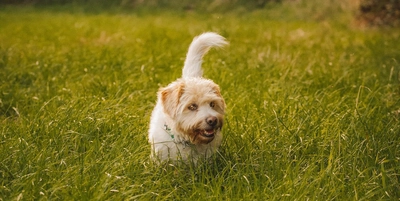Essential First Aid for Dogs
- 23 Apr 2024
- 7m read
.png)
As devoted pet parents, our pooches bring us joy and love every day. But just like us, they can encounter mishaps and health scares.
Whether it's a play session gone wrong or a sudden health crisis, being prepared with some basic first aid knowledge can make all the difference in keeping our pups safe and healthy.
Here's a pawfect guide to essential first aid for dogs.
What to Do if Your Dog Has a Cut or Other Open Wound
Gently clean the wound with mild antiseptic and apply gentle pressure to stop any bleeding.
For deeper cuts or bites, seek veterinary care quickly to prevent infection and ensure proper healing.
What to Do if Your Dog Is Bleeding
Apply direct pressure to the wound using a clean cloth or gauze. Elevate the injured area if possible and maintain pressure until the bleeding stops.
If the bleeding is severe or doesn't stop within a few minutes, seek immediate veterinary attention.
What to Do if Your Dog Has Burns
Immediately flush the affected area with cool water for around 10 minutes to soothe the pain and prevent further damage. Avoid using cold or ice-cold water, as this can worsen the injury.
Loosely cover the burn with a clean, non-adhesive dressing, such as cling film, to protect it and seek veterinary care for further treatment.
What to Do if Your Dog Is Choking
First, contact your vet immediately for assistance.
Assess the situation and stay calm. Your dog will be incredibly scared and unpredictable during this time. They may even bite in response to the stress and pain that they could be feeling. If you can see the object, use tweezers to remove whilst being cautious not to push it further down the throat.
If your dog is unconscious, proceed to carry out a finger sweep by gently opening their mouth and using your thumb and pointer finger to sweep any visible obstructions from the back of the throat.
If this doesn’t work, proceed directly to the Heimlich manoeuvre.
Stand behind your dog and wrap your arms around their abdomen. Make a fist with one hand and place it just below their ribcage. Use your other hand to support the fist and give a series of sharp thrusts upward and inward.
What to Do if Your Dog Has Heat Stroke
If your dog is suffering from heat stroke, swiftly move them to a cool area, offer water in small sips, and use cool flannels or a fan to lower their body temperature. Focus on areas with high blood flow, such as the groin, armpits, and neck.
Do not completely cover your dog with a wet towel, as this will trap heat and could make their condition even worse.
Monitor for symptoms like excessive panting, lethargy, drooling, vomiting, diarrhoea, or collapse and seek immediate veterinary care to prevent life-threatening complications.
Prevention is key; avoid hot environments and provide ample shade and water to keep your dog safe in the heat. If you have any concerns that your dog is suffering from heatstroke, do not hesitate to contact your vet. It is much better to be cautious.
What to Do if Your Dog Has a Seizure
During a seizure, try to remain calm. It can be incredibly distressing to witness this as a pet parent, but a calm demeanour is essential.
Next, ensure your dog's safety by moving any dangers or hazards away from your dog, safety by gently guiding them away from any hazards, such as large pieces of furniture. Dimming the lights and keeping the room as quiet as possible can also help.
Keep track of the seizure's duration and any unusual behaviours. Videoing the seizure to show your vet afterwards can also be hugely helpful. Once the seizure has ended, comfort your pup and call your vet to determine the underlying cause and potential treatment options.
If a seizure lasts two minutes or more, call your vet immediately.
What to Do if Your Dog Has Broken a Bone
If you suspect your dog has broken a bone, prioritise their comfort and safety while seeking immediate veterinary assistance. Keep your dog calm and limit movement to prevent further injury.
Assess the affected area for swelling, deformity, or signs of fracture, and control any bleeding with gentle pressure. Avoid attempting to splint or bandage the injury yourself, as improper immobilisation can worsen the damage.
Swift veterinary evaluation and treatment are essential to ensure proper healing and minimise pain for your pup.
What to Do if Your Dog Has Ingested Something Poisonous
If your dog ingests something poisonous, quick action is essential. Contact your vet or a pet poison helpline immediately for guidance.
Follow their instructions carefully. Do not induce vomiting or take any other actions unless advised by your vet to do so, as this can cause additional harm. Closely monitor your dog for any symptoms or adverse reactions.
If you have any remains of the poisonous item or packaging, bring this with you to the vet as it will help them to identify the appropriate course of action.
What to Do if Your Dog Has Stopped Breathing
Carefully open your dog's airway and check for any obstructions. Administer rescue breaths if necessary and perform CPR if your dog's heart has stopped.
How to Perform CPR on Dogs
Administering CPR to a dog is a crucial skill that can save their life in an emergency. Here's a step-by-step guide:
1. Check for responsiveness
Gently touch your dog and call their name to see if they respond. If they're unresponsive, carefully lay them on their right side on a firm surface.
2. Check for breathing and a pulse
Look, listen, and feel for breathing and a heartbeat. Place your hand on their chest to feel for movement and listen for breath sounds near their nose. Check for a pulse by feeling for a heartbeat near the middle of their chest.
You can also place a glass or a small mirror in front of your dog's nose to determine if they’re breathing. If they’re still breathing correctly, the glass will fog up.
3. Clear the airway
If your dog isn't breathing, carefully open their mouth and remove any visible obstructions, being cautious not to push them further down the throat. Extend their head and neck to straighten the airway.
4. Perform rescue breaths
Close your dog's mouth and place your mouth over their nose, creating a seal. Give two breaths, watching for their chest to rise. If breaths don't enter, reposition their head and try again.
5. Check for a pulse again
After giving rescue breaths, check for a pulse. Place your hand on their chest near the heart and feel for a heartbeat. If no pulse is detected, begin chest compressions.
6. Administer chest compressions
With your dog lying on their right side, place one hand over the widest part of their chest. For medium to large dogs, use both hands overlapped.
Compress the chest 1/3 to 1/2 of its width, performing 30 compressions at a rate of 100-120 per minute.
7. Alternate between compressions and breaths
After 30 compressions, give two more rescue breaths. Continue this cycle of compressions and breaths in a ratio of 30 compressions to 2 breaths until your dog resumes breathing and has a pulse, or until veterinary help arrives.
Remember, CPR for dogs is a temporary measure to keep oxygenated blood circulating until professional veterinary care can be obtained. It's essential to stay calm, focused, and seek immediate veterinary assistance.
What Should a Dog First Aid Kit Contain?
According to the PDSA, a pet first aid kit should contain the following:
Bandages
Blunt-ended scissors
Wound wash / wipes
Cotton wool
Tweezers
Tick remover
Wound dressing
Self-adhesive tape
Dressings
Vinyl gloves
Foil blanket
Antiseptic wipes
A blanket to use as a stretcher
Saline solution
Muzzle (optional, incase your dog bites out of fear or pain)




